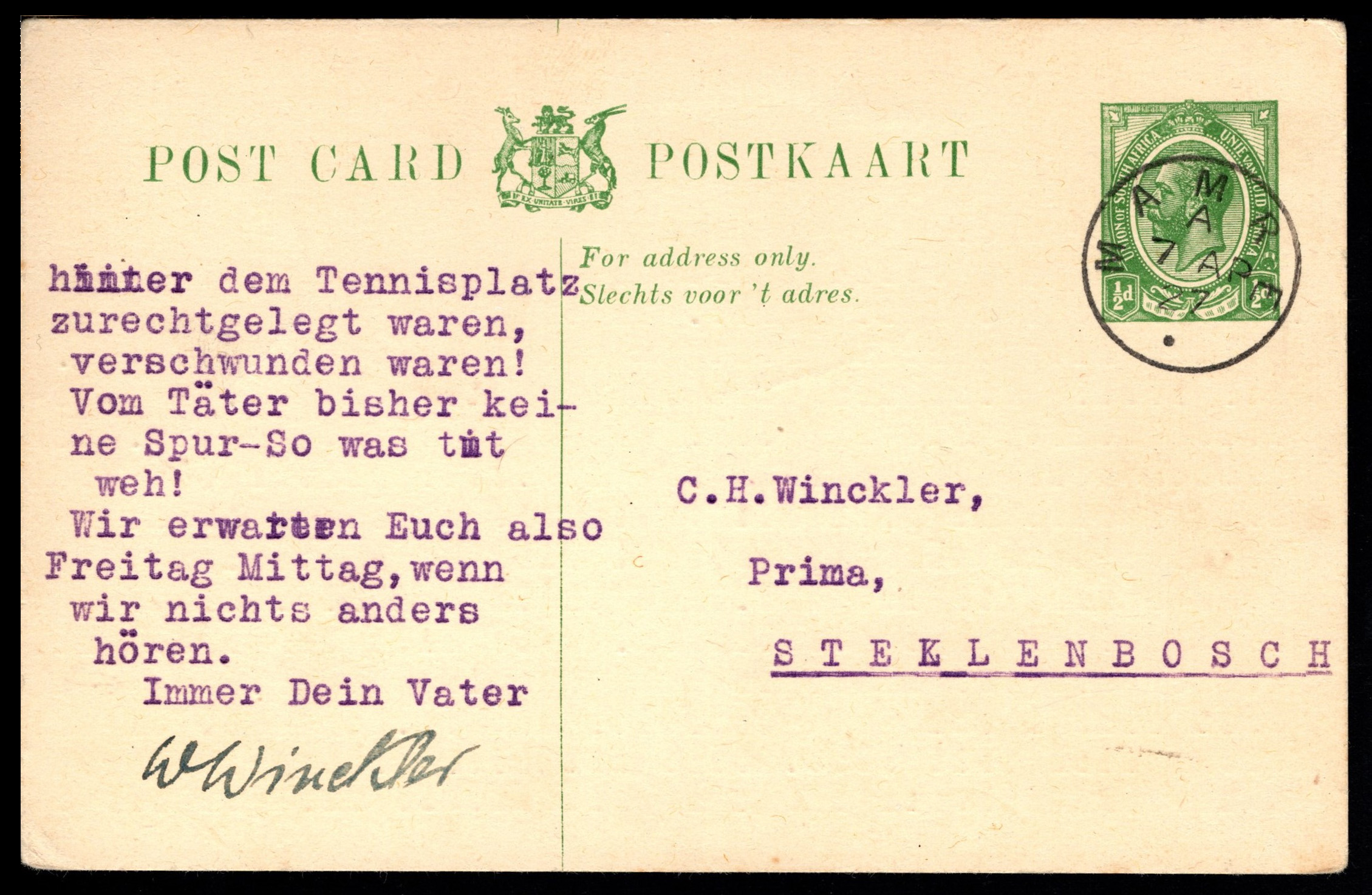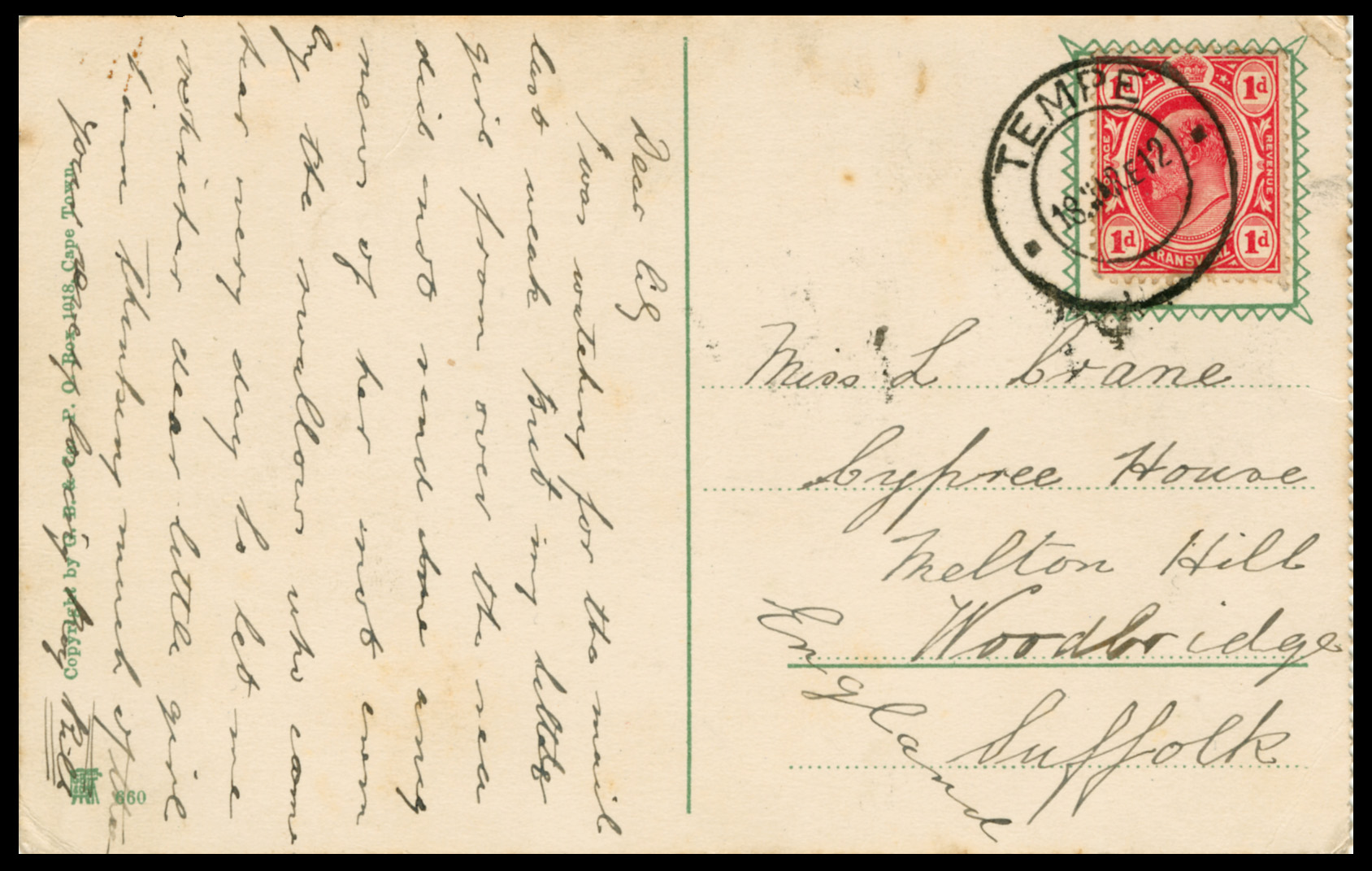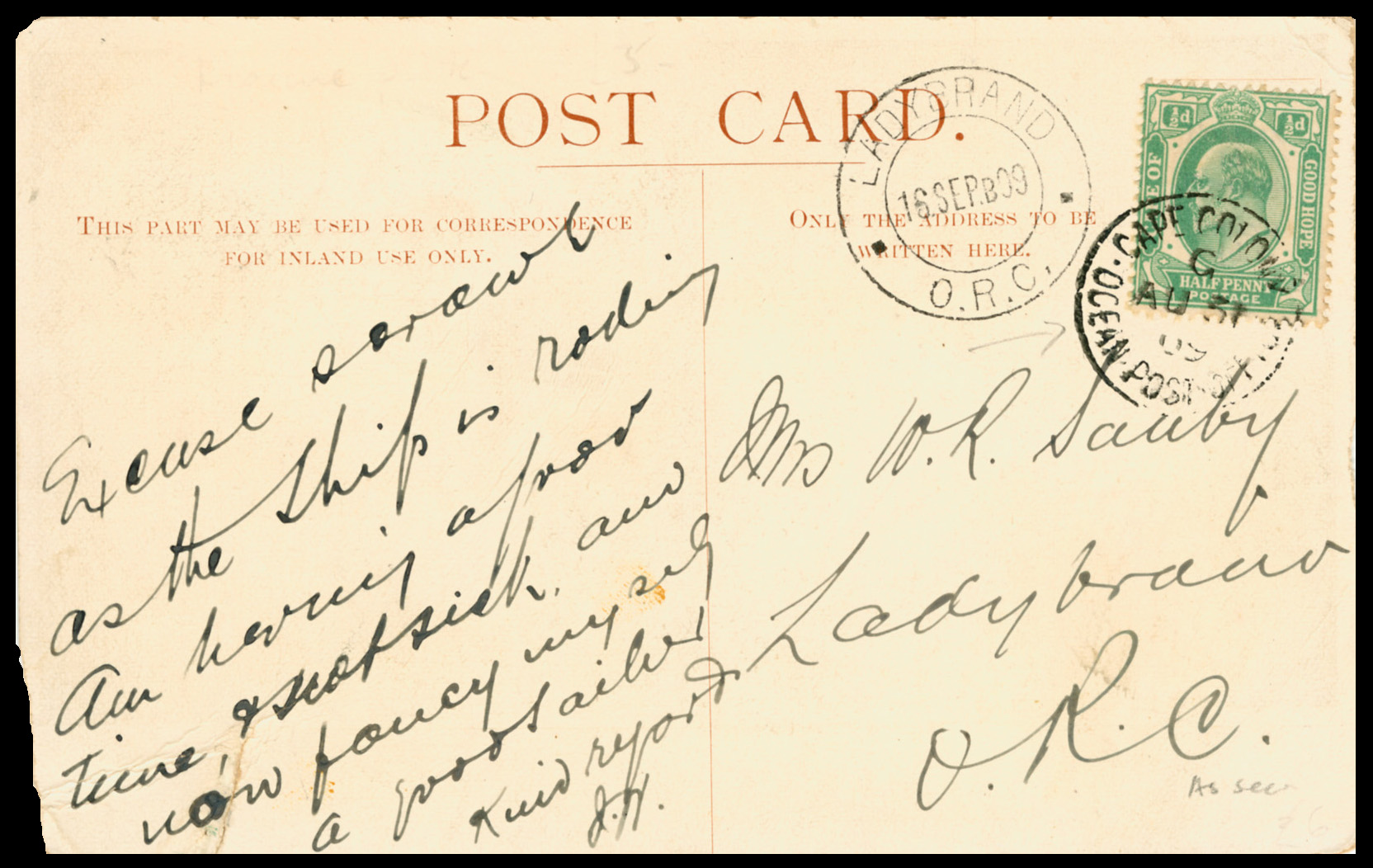Identifying Earliest / Latest Datestamp Use
Quote from Steve on April 28, 2023, 1:09 pmWhy you need to work with the latest Datestamp data!
Sometimes the only way to get a general idea of when a datestamp was introduced or withdrawn is to record its Earliest (ER) and Last (LR) Recorded dates of use. I recently found two unrecorded Oudtshoorn postmarks which allowed me to claim (at this moment in time) possession of both the earliest and the latest dates of use. This 'discovery' came as something of a surprise as I had absolutely no reason to believe they had not been recorded before. They looked common, ordinary, nothing special at all.
Today I had a similar experience, a somewhat unsatisfactory discovery that came in by email auction notification. There was a lesson in the experience, one that I had learned before and forgotten. It is "always use the latest data when attempting to determine earliest and last use of a datestamp!" Fail to do so and you end up embarrassing yourself. As I have done now on several occassion when using old records to report 'new' finds to Alex Visser which were nothing of the sort. (This should not stop you from trying!)
I spotted the item below on Kenny Napier's Edenvale auction. I had reason to call Bob Hill about another item that had come up on the Philatelic Friends auction site and mentioned this MAMRE 'skeleton' cancel to him. I know that Bob has an interest in Skeleton cancellers but this is not as serious a collecting field for him as is Shipping Postmasters, Donald Campbell at Verneukpan, Apartheid, Cape Cork Cancellers or his Kit Kat display. (Sorry, that's an in-joke!). Bob has a good going on great Skeleton canceller collection, maybe 100 or so, but he is never very serious about the subject until I raise the spectre of acquiring his Simonstown Skeleton postmarks for my Simonstown display. Any suggestion by me that he should consider swapping or selling them to me to fill the hole in my display - I've tried for years to find just a single scrappy Simonstown Skeleton postmark on piece - rekindles in him a grim and stubborn passion for the subject. Anyway....
Back to Kenny Napier's MAMRE skeleton type canceller. The item was described as "South Africa card with lovely Mamre skeleton type cancel of 7 Apr 1927". Well, in my opinion, and Bob's (which counts for more), this is NOT a Skeleton canceller at all. It is an example of what Goldblatt calls the 'Circular Datestamp of 1885' of which he says "the distinctive feature of this datestamp is the dot at the bottom". In talking to Bob on the phone he whipped out his 20-year old copy of Frescura which is never far from his hands or the phone when I call. He advised me that Frescura calls this a "Single Circle with Dot 9 to 3 o clock". (Small dot variety.) Its earliest known use in Mamre is 2nd January 1888 and the latest is 29th September 1925. However, when I emailed Alex Visser about my 'new' discovery, he advised me that in the last copy of Frescura's book the last date of known use is 9th June 1927, some two months after Kenny Napier's auction example.
Sadly, this is not the first time I have enthusiatically approached Alex with a new find only to be corrected by him. I am embarrassed to have wasted his time. Again! Nevertheless it is quite incredible how long this Cape colonial datestamp remained in Union use! And it is equally surprising where and how you can make new discoveries, even among the most reputable and knowledgeable dealers.
Why you need to work with the latest Datestamp data!
Sometimes the only way to get a general idea of when a datestamp was introduced or withdrawn is to record its Earliest (ER) and Last (LR) Recorded dates of use. I recently found two unrecorded Oudtshoorn postmarks which allowed me to claim (at this moment in time) possession of both the earliest and the latest dates of use. This 'discovery' came as something of a surprise as I had absolutely no reason to believe they had not been recorded before. They looked common, ordinary, nothing special at all.
Today I had a similar experience, a somewhat unsatisfactory discovery that came in by email auction notification. There was a lesson in the experience, one that I had learned before and forgotten. It is "always use the latest data when attempting to determine earliest and last use of a datestamp!" Fail to do so and you end up embarrassing yourself. As I have done now on several occassion when using old records to report 'new' finds to Alex Visser which were nothing of the sort. (This should not stop you from trying!)
I spotted the item below on Kenny Napier's Edenvale auction. I had reason to call Bob Hill about another item that had come up on the Philatelic Friends auction site and mentioned this MAMRE 'skeleton' cancel to him. I know that Bob has an interest in Skeleton cancellers but this is not as serious a collecting field for him as is Shipping Postmasters, Donald Campbell at Verneukpan, Apartheid, Cape Cork Cancellers or his Kit Kat display. (Sorry, that's an in-joke!). Bob has a good going on great Skeleton canceller collection, maybe 100 or so, but he is never very serious about the subject until I raise the spectre of acquiring his Simonstown Skeleton postmarks for my Simonstown display. Any suggestion by me that he should consider swapping or selling them to me to fill the hole in my display - I've tried for years to find just a single scrappy Simonstown Skeleton postmark on piece - rekindles in him a grim and stubborn passion for the subject. Anyway....
Back to Kenny Napier's MAMRE skeleton type canceller. The item was described as "South Africa card with lovely Mamre skeleton type cancel of 7 Apr 1927". Well, in my opinion, and Bob's (which counts for more), this is NOT a Skeleton canceller at all. It is an example of what Goldblatt calls the 'Circular Datestamp of 1885' of which he says "the distinctive feature of this datestamp is the dot at the bottom". In talking to Bob on the phone he whipped out his 20-year old copy of Frescura which is never far from his hands or the phone when I call. He advised me that Frescura calls this a "Single Circle with Dot 9 to 3 o clock". (Small dot variety.) Its earliest known use in Mamre is 2nd January 1888 and the latest is 29th September 1925. However, when I emailed Alex Visser about my 'new' discovery, he advised me that in the last copy of Frescura's book the last date of known use is 9th June 1927, some two months after Kenny Napier's auction example.
Sadly, this is not the first time I have enthusiatically approached Alex with a new find only to be corrected by him. I am embarrassed to have wasted his time. Again! Nevertheless it is quite incredible how long this Cape colonial datestamp remained in Union use! And it is equally surprising where and how you can make new discoveries, even among the most reputable and knowledgeable dealers.
Uploaded files:
Quote from yannisl on April 29, 2023, 12:21 pmNice item, but I think Bob is right this is not a skeleton canceller. Skeleton postmarks were temporary rubber stamps (in cases I know with larger diameter circles) than the nominal one which was sent for repairs. They had shorter usages presumably because the normal postmark was repaired and returned. Cape of Good Hope/South African postmarks are difficult to pin latest dates of use, as many continued to be used well into the Union period, so if one is collecting Cape I think it is best to pin it at the start of the Union. Frescura was right to say that the ERD and LRD are just indicative. They are moving targets. He classification method for circular cancellers resonated with me for its simplicity and I use it. Your example is SC.DOT (Single circle with dot at bottom) the others are balnk at bottom, split name, CGH at bottom, Cape Colony at bottom etc). Easy to remember and sort. Double circles have an emblem, i.e., DC.Emblem, DC.Numeral and so on.
Nice item, but I think Bob is right this is not a skeleton canceller. Skeleton postmarks were temporary rubber stamps (in cases I know with larger diameter circles) than the nominal one which was sent for repairs. They had shorter usages presumably because the normal postmark was repaired and returned. Cape of Good Hope/South African postmarks are difficult to pin latest dates of use, as many continued to be used well into the Union period, so if one is collecting Cape I think it is best to pin it at the start of the Union. Frescura was right to say that the ERD and LRD are just indicative. They are moving targets. He classification method for circular cancellers resonated with me for its simplicity and I use it. Your example is SC.DOT (Single circle with dot at bottom) the others are balnk at bottom, split name, CGH at bottom, Cape Colony at bottom etc). Easy to remember and sort. Double circles have an emblem, i.e., DC.Emblem, DC.Numeral and so on.
Quote from Steve on April 29, 2023, 12:32 pmWhere to find the latest data on Datestamp usage
Postal history found in traditional print media publications is invariably disappointingly out-of-date as it is incapable of being updated short of a new revised book being published. It is also expensive because it costs a lot to print and update books. The early South African postal historians like Berry, Goldblatt and Putzel did not think to list first and last use of datestamps, probably because it is so much extra work. The first to do so in a serious academic way was Prof. Franco Frescura with his landmark 'The Post Offices of the Cape of Good Hope 1792-1910' in 2003.
This led other postal historians working in other areas to follow suit. The good news is that first and last dates of use is increasingly available for free on-line. Perhaps the most remarkable postal historian is Prof. Alex Visser who after collaborating with the dying Ralph Putzel created a free on-line Addendum to Ralph's and his work. Today, Alex's Addendum is roughly equal in size to Ralph's original work. However, it offers no data on first and last dates of use. Its usefulness is diminished by the fact that because it is an Addendum to a printed book ie. you have to own the books to get the full list of a town's recorded datestamps.
The PFSA has had the great good sense makes its reference section FREE on its website. IMO, this is exactly how philately should work - free from the top down. The PFSA's site includes the most recently updated version of Alex's Addendum (which covers states, colonies, Union and Republic, etc., but without first and last date of use). This may never be included because there are now other lists like Cape of Good Hope (essentially Frescura's work), Orange Free State, German SWA, ZAR/Transvaal and Swaziland, that do list first and last dates of use. All are works in progress, some being more complete than others. For example, the OFS list is complete from A - Z but others are still working towards a conclusion. Those who make free use of their research should be grateful to them for their work. The way to show our appreciation is to diligently send them any new and unrecorded data as we find it.
You can see the electronic listing on the PFSA website: www.stampssa.africa
Go to RESOURCES > POSTMARKS > then choose your area from the drop down menu.Typically, you then select a section based on the first letter of the Town's name, like 'O' for Oudtshoorn, etc.
'Orange Free State - Its Post Offices and Their Markings - 1854 to 1910'
I enjoyed looking at the OFS reference which, to my shame, I did not know existed. Its correct title is 'Orange Free State - Its Post Offices and Their Markings - 1854 to 1910' (Kevin Price). I have a stack of OFS material in boxes that I still want to write-up. This comprehensive reference will help enormously in simpifying the process.Below are two covers that I looked up in Kevin's on-line reference today. The top postcard is a new addition to my 'Cantonments' display. It is from TEMPE and is a good strike of a postmark that Kevin does not show as an example of the type, stating only that it is a variety, 'Type 660 (with the O.R.C. removed)'. The lower postcard is from LADYBRAND. As it had been lying on my desk for a few days I idly looked it up. To my great surprise it is postmarked two weeks earlier than the OFS reference's earliest date of 29 Sep 09 for this datestamp. So, I sent it off to Kevin, the author/editor. He replied 'good catch!". You can do this too. It all helps.
Where to find the latest data on Datestamp usage
Postal history found in traditional print media publications is invariably disappointingly out-of-date as it is incapable of being updated short of a new revised book being published. It is also expensive because it costs a lot to print and update books. The early South African postal historians like Berry, Goldblatt and Putzel did not think to list first and last use of datestamps, probably because it is so much extra work. The first to do so in a serious academic way was Prof. Franco Frescura with his landmark 'The Post Offices of the Cape of Good Hope 1792-1910' in 2003.
This led other postal historians working in other areas to follow suit. The good news is that first and last dates of use is increasingly available for free on-line. Perhaps the most remarkable postal historian is Prof. Alex Visser who after collaborating with the dying Ralph Putzel created a free on-line Addendum to Ralph's and his work. Today, Alex's Addendum is roughly equal in size to Ralph's original work. However, it offers no data on first and last dates of use. Its usefulness is diminished by the fact that because it is an Addendum to a printed book ie. you have to own the books to get the full list of a town's recorded datestamps.
The PFSA has had the great good sense makes its reference section FREE on its website. IMO, this is exactly how philately should work - free from the top down. The PFSA's site includes the most recently updated version of Alex's Addendum (which covers states, colonies, Union and Republic, etc., but without first and last date of use). This may never be included because there are now other lists like Cape of Good Hope (essentially Frescura's work), Orange Free State, German SWA, ZAR/Transvaal and Swaziland, that do list first and last dates of use. All are works in progress, some being more complete than others. For example, the OFS list is complete from A - Z but others are still working towards a conclusion. Those who make free use of their research should be grateful to them for their work. The way to show our appreciation is to diligently send them any new and unrecorded data as we find it.
You can see the electronic listing on the PFSA website: http://www.stampssa.africa
Go to RESOURCES > POSTMARKS > then choose your area from the drop down menu.
Typically, you then select a section based on the first letter of the Town's name, like 'O' for Oudtshoorn, etc.
'Orange Free State - Its Post Offices and Their Markings - 1854 to 1910'
I enjoyed looking at the OFS reference which, to my shame, I did not know existed. Its correct title is 'Orange Free State - Its Post Offices and Their Markings - 1854 to 1910' (Kevin Price). I have a stack of OFS material in boxes that I still want to write-up. This comprehensive reference will help enormously in simpifying the process.
Below are two covers that I looked up in Kevin's on-line reference today. The top postcard is a new addition to my 'Cantonments' display. It is from TEMPE and is a good strike of a postmark that Kevin does not show as an example of the type, stating only that it is a variety, 'Type 660 (with the O.R.C. removed)'. The lower postcard is from LADYBRAND. As it had been lying on my desk for a few days I idly looked it up. To my great surprise it is postmarked two weeks earlier than the OFS reference's earliest date of 29 Sep 09 for this datestamp. So, I sent it off to Kevin, the author/editor. He replied 'good catch!". You can do this too. It all helps.
Uploaded files:Quote from Steve on December 23, 2025, 3:18 pmThis Forum topic was in need of an update. As a result of my inability to submit new postmarks and Earliest / Latest dates to the PFSA's Alex Visser who updates Putzel's (and his) reference works with new finds on-line I decided to post this here.
I have never not been able to contact Alex Visser before. My reason for posting this here now is that I have a new LATEST RECORDED HCD (Hooded Circular datestamp) for GRAHAMSTOWN, a subject on which Alex and I collaborated.
GRAHAMS TOWN HCD (* for Time Code, Dot). Previously '28 OC 1891': NOW: 'NO 15 91'. (Kenny Napier Auctions)
The postmark of the Hooded Circular Datestamp shown is not great but I believe there is enough to see that it is from GRAHAMS TOWN, that there is smudged dot between the 'S' and the 'T', that there is the remnant of an asterisk at top and that the date is 'Nx 15 91'. The month is confirmed by the clear as daylight KIMBERLEY receiving date stamps of 'NO 18 91'.
The fact that the postmark is smudged and unclear is typical of a distressed datestamp that has come to the end of its working life. This is the reason why it is going to be replaced. It is appropriate then that it should be in this condition. See it in the link here.
INDIAN OFFICE PIETERMARITZBURG: '1945/52' (Bob Hill)
This is a relatively new postmark that does not appear in Putzel. It is recorded in Alex Visser's online Addendum with the following note " No. 2, 4/20. 26 mm circle. Full date with time code letter. (1949/52)." It matches in every detail except the Year date.
As this postmark is cancelled '9 FEB 45', the note should be updated to read '1945/52'
ALICE Single Circle Datestamp: '3 MR 22' (Bob Hill)
When checking Putzel for a postmark and you do not find it, you should always look at the PFSA's website under RESOURCES > POSTMARKS to check if what you have has not already been reported or updated.
There is no new version of this postmark on the PFSA website under SA POSTMARKS. The Earliest (ER) and Latest Recorded (LR) use of it appears in Franco Frescura's and Alex Vissers's "Revised Listing of The Postmarks of the Cape of Good Hope". Of this postmark it says: "SC (Single Circle) BAB (Bare at Base) name 10 - 2 o'clock. ER '25 JY 1901' LR '27 OC 1921'.
As this postmark is cancelled '3 MR 22', the LR should be updated to read 3 MR 22'
This Forum topic was in need of an update. As a result of my inability to submit new postmarks and Earliest / Latest dates to the PFSA's Alex Visser who updates Putzel's (and his) reference works with new finds on-line I decided to post this here.
I have never not been able to contact Alex Visser before. My reason for posting this here now is that I have a new LATEST RECORDED HCD (Hooded Circular datestamp) for GRAHAMSTOWN, a subject on which Alex and I collaborated.
GRAHAMS TOWN HCD (* for Time Code, Dot). Previously '28 OC 1891': NOW: 'NO 15 91'. (Kenny Napier Auctions)
The postmark of the Hooded Circular Datestamp shown is not great but I believe there is enough to see that it is from GRAHAMS TOWN, that there is smudged dot between the 'S' and the 'T', that there is the remnant of an asterisk at top and that the date is 'Nx 15 91'. The month is confirmed by the clear as daylight KIMBERLEY receiving date stamps of 'NO 18 91'.

The fact that the postmark is smudged and unclear is typical of a distressed datestamp that has come to the end of its working life. This is the reason why it is going to be replaced. It is appropriate then that it should be in this condition. See it in the link here.
INDIAN OFFICE PIETERMARITZBURG: '1945/52' (Bob Hill)
This is a relatively new postmark that does not appear in Putzel. It is recorded in Alex Visser's online Addendum with the following note " No. 2, 4/20. 26 mm circle. Full date with time code letter. (1949/52)." It matches in every detail except the Year date.
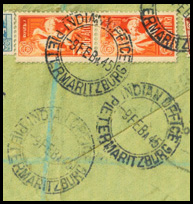
As this postmark is cancelled '9 FEB 45', the note should be updated to read '1945/52'
ALICE Single Circle Datestamp: '3 MR 22' (Bob Hill)
When checking Putzel for a postmark and you do not find it, you should always look at the PFSA's website under RESOURCES > POSTMARKS to check if what you have has not already been reported or updated.
There is no new version of this postmark on the PFSA website under SA POSTMARKS. The Earliest (ER) and Latest Recorded (LR) use of it appears in Franco Frescura's and Alex Vissers's "Revised Listing of The Postmarks of the Cape of Good Hope". Of this postmark it says: "SC (Single Circle) BAB (Bare at Base) name 10 - 2 o'clock. ER '25 JY 1901' LR '27 OC 1921'.
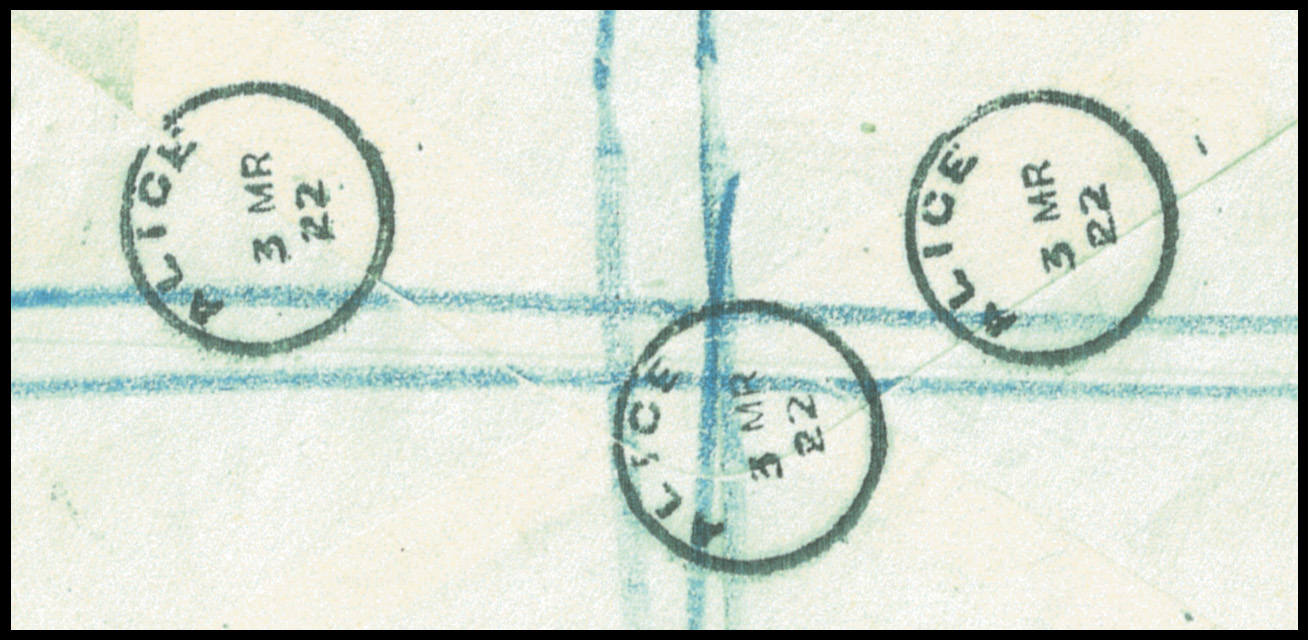
As this postmark is cancelled '3 MR 22', the LR should be updated to read 3 MR 22'

